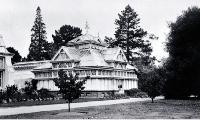![]()
Annie Quayle Moore was born in Sydney about 1845, the only surviving daughter of the loveless marriage of George Henry Moore and Annie Kermode. After a childhood in her father's birthplace, the Isle of Man, she came to Canterbury to supervise Moore's house at the Glenmark sheep station. Moore, the 'king of scab', refused to clean his sheep. When asked about his duty to his neighbours, he retaliated: 'What do I care for my neighbours?' A swagman was turned away from the door, committed suicide, and Moore refused to let his carpenters build a coffin. The newspapers castigated the 'wool baron' as 'mean, barbarous, hard-hearted, blasphemous'.
Moore's son, William, died young and estranged. Annie remained a spinster, Moore insisting that would-be suitors were after her money. In 1881 the old man commissioned the building of a castle-type home with rich internal decoration. The place was completed in 1888, father and daughter living in secluded splendour till the uninsured structure was gutted three years later.
With Moore slipping into blindness, Annie seized her chance, and in 1900, entered into a secret union. Her husband, the widowed doctor Joseph Henry Townend, died two years later. 'Scabby' Moore, who never knew of the wedding, died in 1905.
Annie now bought a four-acre Fendalton property, 'Karewa'. A homestead was on the site, but Annie added the lodge off Fendalton Road and the 'bath-house' from the 1906-07 exhibition. She increased the size of the property by nine acres, extended the landscaping and added to the variety of trees and plants. She gave the estate the name of her mother's Tasmanian home, 'Mona Vale', and the name has endured. After much debate, the land came into local authority hands in the 1960s.
Annie ensured that her Sumner home was controversially in the public eye in her own lifetime. After a dispute with the borough council, the great lady showed her independence by employing W H Williamson to uplift the structure, and carry it on two traction engines to Cashmere, and then up the cart track which became Dyers Pass Road. Children were taken to gape at the spectacle. The main part of the house, Glenholme, came to rest at No 8 Macmillan Avenue, while a smaller section of the building, at No 3, housed the coachman.
Annie's dealings with the Tax Department also attracted attention.From 1893 G H Moore sold off Glenmark land, stashing half a million pounds in his daughter's bank account. On the old man's death, Annie was left not only as trustee of the estate but also its main beneficiary. The Tax Department stepped in, took the estate to court, and argued that the family was trying to evade death duties. The judge decided that the Moores' attempt to evade the penalties of the law was no reason for a penalty to be imposed.
As a memorial to her father, Annie gave £30,000 to the Anglican diocese to acquire land for a church and vicarage and to endow a vicar's stipend at Glenmark. St Paul's was consecrated in 1907 'in the presence of a large number of visitors, many of whom had come by special train from Christchurch'. Today 'the brick church, with its spire, makes a conspicuous and unexpected landmark. Placed on a slight hill, and surrounded by stately trees, it is a source of pride and pleasure to the district'.
Although she showed many of her father's characteristics, Annie practised a 'constant quiet charity, being secret almost in the way she aided others'. She supported the Canterbury Agricultural and Pastoral Association, and furthered the breeding of sheep in the province. She loved flowers, and left to the city a large conservatory and orchid house. This stood in the grounds of Holly Lea but was re-erected in the Botanic Gardens and named the Townend House. It contained year-round displays of colourful glasshouse plants. Eventually it was removed, and the present Townend House built on the site.
Annie died in 1914. The newspaper details of the will of the richest woman in the South Island constituted 'perhaps one of the most interesting bits of local news ever published'. Churches and charitable institutions benefited to the tune of £45,100. Large sums went to servants, solicitors, Anglican clerics, an Isle of Man relative, and Annie's step-children.
Sources
- 'Annie Quayle Townend and her houses', Press, 13 October 1984
- Barnett, M J, Garden century: the Christchurch botanic gardens, 1863-1963, 1962
- Britten, Rosemary, 'Annie Townend and her other house', Press, 18 August 1984
- Brittenden, W J A, 'Unravelling the origins of 'Karewa' or 'Mona Vale', Press, 20 July 1984
- Church news, 1 June 1914, Church House, Christchurch
- Church register transcripts, Christchurch City Libraries
- Dictionary of New Zealand biography, 1990
- Macdonald biographical dictionary, Canterbury Museum
- New Zealand church news, November 1907, Church House, Christchurch
- Parr, Stephen, Canterbury pilgrimage, 1951
- Provincial perspectives, 1980
- Weekly Press, 20 January 1909
- Wilson, J L 'Story of Glenmark', Weekly press, 23 June 1915
- Jimmy McAloon kindly provided information from his Ph D research on wealth in the South Island, and Jane Davies assisted with entries from the Church news and New Zealand church news
Other resources - Christchurch City Libraries
- Catalogue search on Annie Quayle Townend
- Notable graves - Upper Riccarton Cemetery Area 2 Row B no. 248


 Discover your family’s history at our libraries
Discover your family’s history at our libraries


